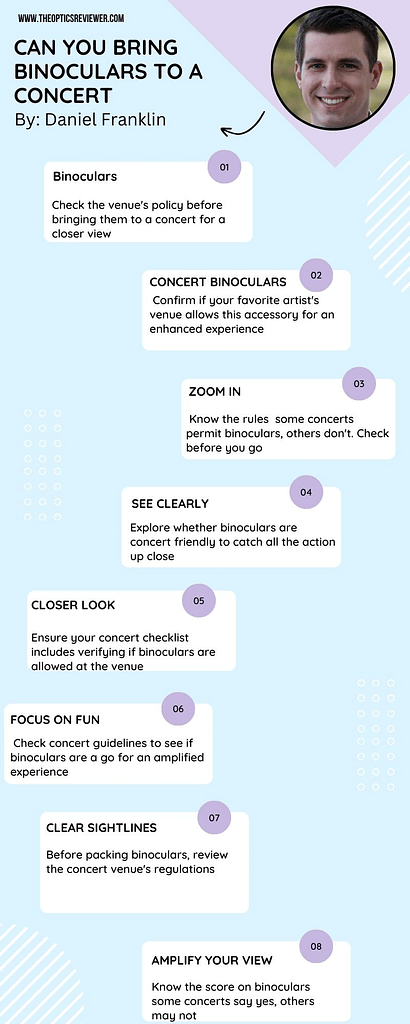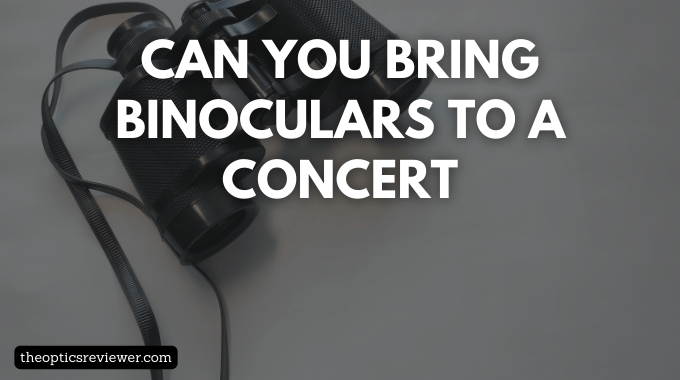If you are all excited about an upcoming concert of your favorite artist but at the last moment, a series of questions pop into your head like “Can you bring binoculars to a concert?” or “What should you or should not bring to a concert? Then you, my friend, need not worry because we got your back. We aren’t going to let these frivolous questions ruin your day. Here we will answer all your queries regarding the concert essentials and whether or not you should carry a pair of binoculars with you.
So without much ado, let us dive deep into the world of binoculars and help you understand what you’re going to need to make the upcoming concert one of the best experiences of your life.
Contents
- 1 Key Highlights
- 2 Can You Bring Binoculars to a Concert?
- 3 Why Do We Need Binoculars in a Concert?
- 4 Can You Bring Binoculars to a BTS Concert?
- 5 How to Bring Binoculars to a Concert?
- 6 How to Buy Binoculars and Choose The Right Pair For Concerts?
- 7 What are The Best Binoculars to Bring to a Concert?
- 8 What are Some Concert Essentials?
- 9 Can I Bring a Camera to a Concert?
- 10 What Should You Not Bring to a Concert?
- 11 Conclusion
- 12 References
- 13 FAQs
- 13.1 Should You Bring a Water Bottle to The Concert?
- 13.2 Can You Bring Binoculars to a Stadium?
- 13.3 What is the Best Binocular Magnification For Concerts?
- 13.4 How Long Does a Concert Last?
- 13.5 How Should I Dress For a Concert?
- 13.6 Can You Bring Binoculars to a Concert?
- 13.7 How Far Can You See With 40X60 Binoculars?
- 13.8 How Far Can Military Binoculars See?
Key Highlights
- Verify the concert venue’s rules regarding bringing binoculars to ensure compliance with their specific regulations.
- Opt for compact and lightweight binoculars for convenience and to comply with any size restrictions imposed by the venue.
- Be considerate of others by using binoculars discreetly to avoid obstructing the views of fellow concertgoers.
- Select binoculars with good low-light performance if the concert extends into the evening, enhancing your viewing experience.
Can You Bring Binoculars to a Concert?
Why not? You can bring a pair of binoculars to a concert to get the most out of this experience. The musical event is a great event to bring your binoculars to. When you attend a show, you want to see the performers and the stage, and that’s where binoculars will come in handy. Your binoculars make it possible to see the stadium and the performers on any given day, and you’ll be able to enjoy all that your eyes can take in.
With the best low light binoculars, you’ll also see everything with exceptional clarity, even in low light conditions like at night. This is why having quality binoculars is essential when attending concerts, sporting events, musical performances, or other events.

Why Do We Need Binoculars in a Concert?
One of the biggest reasons people attend concerts is to see their favorite artists performing. Whether they are rock bands, pop stars, or opera singers performing, their fans want to grasp the essence of the entire experience fully.
So what better tool could there be than binoculars to see everything going on the stage, even if you got a spot far away from it? It just makes sense to have binoculars if you want to take in everything, including the whole craziness on the stage and the performers’ facial expressions. Hence, binoculars will really come in handy when you want to watch your favorite artist at a concert or open-air music festival without getting trampled by fans storming the stage.
Can You Bring Binoculars to a BTS Concert?
There is no issue in bringing binoculars to a BTS concert; be sure to carry them in a transparent bag instead of their original carrying case.

How to Bring Binoculars to a Concert?
One of the most important things to consider when you are planning to bring binoculars to a concert is the size of the binoculars. You may think getting a larger pair of binoculars would be more convenient, but this is not always the case. The size of the binoculars will determine whether or not you can see everything in the concert hall and whether you can carry it around the whole time. This section discusses how to bring your binoculars to concerts.
Instead of carrying your binoculars in their case, you should take them in a transparent bag because most concert halls, stadiums, and venues do not allow you to bring a binocular case.
How to Buy Binoculars and Choose The Right Pair For Concerts?
A binocular helps you see objects up close and in color, whether you’re looking at the stars or other views. Binoculars range from simple optical devices that only use one lens to advanced models with multiple lenses, allowing you to see more detail than ever.
We are all familiar with buying binoculars but need to learn more about choosing the perfect pair of binoculars for shows. This section is about selecting a pair of binoculars and getting the best performance out of them.
Now, once we have settled the question of whether you can bring binoculars to a concert, let’s focus on choosing a pair of binoculars and what to look for. There are a lot of different kinds of binoculars on the market today that you can use to help you enjoy your view. There is a binocular for every budget and for every need. You have to make sure you know the difference between them. An excellent way to determine which is better for you would be by trying out and comparing both models before making a purchase decision for your performance and entertainment needs.
Now, here we are going to discuss some features you need to consider to land on the perfect pair of binoculars to enjoy concerts and musical nights.
Magnification
Magnification is the degree to which a pair of binoculars brings the world closer to your eyes. Most specialists agree that the optimum magnification for binoculars lies between 7x and 10x, depending on the purpose for which you want to use particular binoculars.
For instance, in the case of musical performances in concert halls, you can settle for a pair of binoculars offering a magnification of 4 to 8x. On the other hand, when it comes to open-air concerts, it is better to go for 8x magnification.
Objective Lens Diameter
Objective lens diameter shows the size of the aperture, which controls the amount of light transmitted; thus, a hefty objective lens displays excellent light-gathering ability.
Hence, the larger the lens diameter, the more light it transmits and the brighter the view you would get. It will be best if you consider the option that offers you a large, at least 42 or 50 mm objective lens diameter that can ensure a quality view with true-to-life color from sunrise to sundown.
Field of View
The FOV accounts for the total area or the horizontal width of the view you can grasp with a pair of binoculars without moving your head. In the case of the field of view, the broader, the better rule sets in as with a wider field of view, you would be able to spot the thing you want to focus on instantly, and it would ensure that you won’t miss out on any crucial or once in a lifetime moment.
A field of view wider than 315 feet at 1000 yards (105m at 1,000 meters / 6.0°) would serve its purpose justly.
Lens Coating
The binocular lens coatings mostly add to the light transmitted through the lens. Hence increases the brightness, saturation, and contrast of images with better color reproduction and color fidelity, where contrast means the difference in luminance between adjacent bright and murky areas. The higher the contrast is, the sharper and more brilliant the imaging is perceived to be.
It will help if you look for fully multi-coated lenses, as they have several coatings on all air-to-glass surfaces with different refractive indices. The fully multi-coated optics being on the high-end ensures the amount of reflected light to its lowest. At the same time, it considerably increases the optical performance and ensures impressive low-light performance. Last but not least, the fully multi-coated lens also guarantees the absence of any chromatic aberration.
Eye Relief
Just because you are an eyeglass wearer does not mean you can’t enjoy the full view of the concert, as many binoculars provide optimum eye relief to ensure you can enjoy the sight without straining your eyes. Eye relief is the optimum distance between your eyes and the eyepiece of the binoculars, and it is a crucial consideration for eyeglass wearers. More precisely, it is the distance from the eyepiece lens’s outer surface to the point where the exit pupil is formed. The viewer can only grasp the whole essence of the picture if his eye is within this distance. It will be best to look for good eye relief binoculars that provide at least 16 mm of eye relief.
Low Light Performance
We all want a pair of binoculars that provide bright and sharp imaging from dusk to dawn. So low light performance is something you should consider while out buying binoculars for a concert.
Apart from ensuring that your binoculars have at least an exit pupil of 5 mm, it will help if you also look for features like whether or not the binoculars have extra-low dispersion (ED) glass, anti-reflective coatings, etc.
Prism Type
Prism serves to invert the otherwise upside-down images so that you can see the view as it is. The binoculars come equipped with either a Porro prism or a Roof prism.
A Roof prism is lighter in weight, smaller in size, with more optical precision, and a bit more expensive than the bulky Porro prism, which, on the other hand, offers greater depth perception.
Durability and Weather Resistance
Durability is a feature you should pay attention to while buying a pair of binoculars. Most binoculars now offer rugged rubber armoring that adds an extra layer of protection for the binoculars and gives them a firm grip.
Apart from that, you can only sometimes predict the weather when you are out in the open to watch your favorite artist’s concert. So you and your optical gadget should always be ready for any erratic change in weather. So what you should do is look at the durability of the model.
Size
There is no doubt that small-sized binoculars have a comparatively low field of view and less brightness than the larger ones, but who can deny that in a fully crowded concert hall, everyone wants an easy-to-carry lightweight option?
So what we can do is bring medium-sized lightweight binoculars that will not only provide you with excellent imaging but will also make the whole experience more enjoyable and less tiring.
Budget
Budget is also an essential factor that drives your binoculars choice. The price must also be affordable since you want to spend only what is required on them.
What are The Best Binoculars to Bring to a Concert?
Musical events are one of the most entertaining events in a person’s life. A concert is a big event, and it requires high-end binoculars to be able to watch it. Here are the best binoculars for shows that will make you a fan of them.
- Wingspan Optics FieldView 8X32 Compact Binoculars
- Bushnell H2O 8×42 Roof Prism Binoculars
- Aurosports 10×25 Binoculars
- Athlon Optics Midas 8×42 Binoculars
- Nikon Trailblazer 8×25 ATB Waterproof Black Binoculars
- SkyGenius 8×21 Compact Binoculars
- Bushnell Spectator 4x30mm Extra-Wide Compact Binoculars
- Vanguard Orros 8×25 Binoculars
- SkyGenius 10×25 Compact Binoculars
- POLDR 12X25 Small Pocket Binoculars
What are Some Concert Essentials?
Following are some things you should carry along when going to a concert.
- Concert tickets: Yeah! We know that is quite basic, but a reminder won’t hurt anyone.
- Binoculars: Well, if you got a spot far away from the stage, then a pair of binoculars will come in handy to enjoy the whole essence of the view that your unaided eyes can’t entirely do justice to.
- Wallet and IDs: Let’s be honest; you need to have your ID and cash on hand when at a concert.
- Hair ties: Now, you may want to flaunt those luscious hair locks of yours in the concert, but after some dancing time, some hair ties may be helpful to keep those hair locks from the face.
- Sunscreen: If you attend an outdoor concert in summer, it is better to keep your sunscreen with you to protect your skin from the sun’s harmful rays.
- A mini backpack or a transparent bag to hold all your essentials
- Tissues or antiperspirant wipes
Can I Bring a Camera to a Concert?
Until and unless stated otherwise, concertgoers may bring small cameras and cell phones, but it is always best to look at the site where you booked your online concert ticket because they have all the rules and regulations listed there. Moreover, concert halls or specific venues prohibit the use of cameras with detachable lenses.
What Should You Not Bring to a Concert?
Well, you would want to refrain from taking anything that causes nuisance or disturbance for other people, like beach balls, laser pens, noisemakers, bullhorns, etc. The underlying reason is everyone is there at the concert to enjoy it, so you wouldn’t want to ruin that moment for anyone, right? Moreover, it will be best if you refrain from bringing anything illegal like drugs or weapons or stuff like cigarettes or alcohol.
Conclusion
At last, this whole discussion of can you bring binoculars to a concert has come to an end. We hope you have fully understood all the dos and don’ts of the concerts and musical performances. So next time you go to a show of your favorite artist, remember to keep a good pair of binoculars with you to get the most out of your musical night experience.
Enjoy your musical night!
References
- https://www.sciencedirect.com/science/article/pii/0165380683901803
- https://core.ac.uk/download/pdf/212800020.pdf
- https://coopereyecare.com/wp-content/uploads/sites/9/2021/08/Intermittent-Exotropia-of-the-Divergence-Excess-Type-Basic-and-Divergence-Excess-Type.pdf
- https://link.springer.com/article/10.1007/BF00229264
FAQs
Should You Bring a Water Bottle to The Concert?
Always choose the safer route and leave your water bottle at home if you’re unsure about the policy at a specific concert. Now, if you’re thinking about what you’re going to do if you feel thirsty midway through the show, my friend, most venues feature water fountains or water stations where you may fill up your cup without spending a penny, and you can quench your thirst this way.
Can You Bring Binoculars to a Stadium?
You can bring your pair of binoculars to a stadium to get the most out of the game. It is recommended that instead of carrying it in its original carrying case, it is better to bring it in a transparent bag, or if you own a small, lightweight option, you can carry it around in your hands.
What is the Best Binocular Magnification For Concerts?
In the case of musical performances in concert halls, you can settle for a pair of binoculars offering a magnification of 4 to 8x. On the other hand, when it comes to open-air or outdoor concerts, it is better to go for 8x magnification.
How Long Does a Concert Last?
The exact duration depends on the artists and the organizers, but a decent estimate is between 90 and two hours, and sometimes there can also be a 15 to 20-minute break. But in specific scenarios, performance can go on for much longer, anywhere from two and a half to three hours.
How Should I Dress For a Concert?
When it comes to concert attire, you don’t have to go all out and should opt for loose-fitting, comfortable clothes. Don’t dress in clothing that is either too hot or too tight. Wear loose-fitting, breathable clothing because you will be dancing all night long and don’t want to be uncomfortable. For maximum comfort, you can go for loose-fitting T-shirts and jeans. In case the weather is cold, you can also bring a sweater or cardigan to layer.
Moreover, it is better to opt for sneakers instead of flip flops or high heels when it comes to footwear because you would want to become comfortable during the concert.
Can You Bring Binoculars to a Concert?
Most concert venues generally prohibit bringing binoculars as they can be disruptive to others and may obstruct the view. It’s advisable to check the specific venue’s rules and regulations before bringing binoculars to a concert.
How Far Can You See With 40X60 Binoculars?
With 40X60 binoculars, you can typically see objects in clear detail at distances ranging from a few hundred yards to several miles, depending on atmospheric conditions and the size of the target.
How Far Can Military Binoculars See?
The range of military binoculars varies, but they can typically see distances ranging from a few hundred meters to several kilometers, depending on the specific model and specifications. Advanced technologies, such as image stabilization and high magnification, contribute to their ability to observe targets at longer distances.

